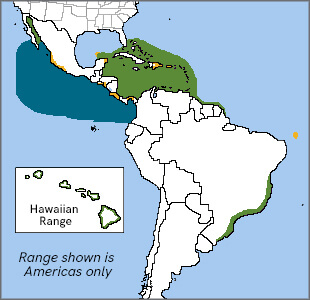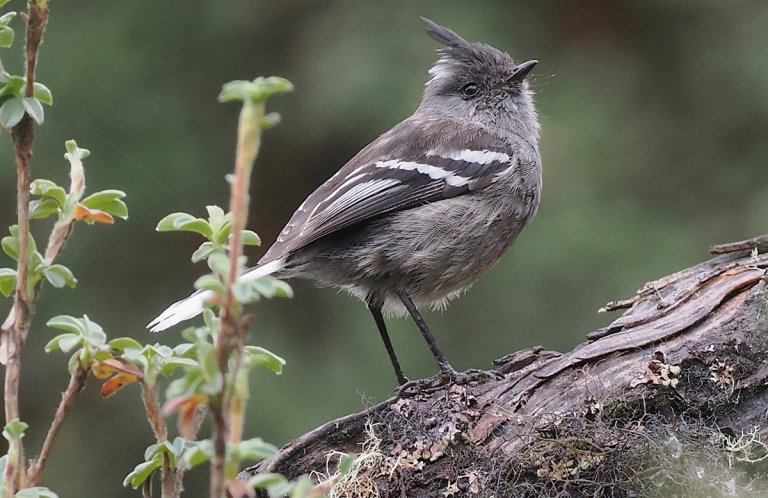 The Brown Booby is the most common and wide-ranging member of its oceangoing family. It's also one of the more eye-catching, with chocolate-brown upperparts that contrast with a white belly, and bright yellow legs and feet. The Brown Booby's species name leucogaster is from Ancient Greek leuko for "white" and gaster for "belly."
The Brown Booby is the most common and wide-ranging member of its oceangoing family. It's also one of the more eye-catching, with chocolate-brown upperparts that contrast with a white belly, and bright yellow legs and feet. The Brown Booby's species name leucogaster is from Ancient Greek leuko for "white" and gaster for "belly."
This distinctive seabird shares its tropical range with the Red-footed Booby and other pelagic birds, such as the Laysan Albatross and White-tailed Tropicbird.
Origin of a Silly Name
The name "booby" comes from the Spanish word bobo, meaning stupid or daft. Like all species in its family, the Brown Booby is a strong and graceful flier. However, it's clumsy when on land, especially during takeoffs and landings. This apparent clumsiness, combined with a fearlessness that comes from little human contact, gave early explorers the impression that these big seabirds had small brains.
Wandering Widely
Brown Boobies are found across tropical regions of the Atlantic, Pacific, and Indian Oceans. In the Americas, they breed on islands off the Pacific Coast, in the Gulf of Mexico, and in the Caribbean. Outside of their breeding season, they wander widely, turning up along the Pacific or Atlantic coasts and sometimes straying as far inland as California's Salton Sea.
Off-season locations are not well studied for this species: The Brown Booby does not need to roost on land. When it needs to rest, it can simply set down on the surface of the ocean.
Diving for Dinner
Brown Boobies tend to feed on inshore waters, where they prey on small fish and squid. Powered by long, pointed wings, these agile seabirds hunt by plunging into the sea from heights of 30 to 50 feet. Torpedo-shaped bodies and air sacs under their skin cushion their impact with the water. They plunge into the water like darts, then can swim underwater to feed. Or they snatch prey directly from the water's surface. Great Frigatebirds and other frigatebird species often harass Brown Boobies, chasing them and forcing them to disgorge their prey.
A Notable Nester
Like most seabirds, the Brown Booby breeds almost exclusively on islands, some close to shore and others far out in the middle of the ocean. Males and females have similar plumage, but differ in the color of their facial skin — males with blue skin and females with yellow. These colors become particularly intense during the breeding season. (In eastern Pacific birds, a population known as “Brewster's Booby,” males have distinctive grayish-white heads.) Mated pairs may stay together over several years. Many Brown Booby populations follow no set nesting season.
Unlike other ground-nesting Sula species, Brown Boobies usually build a good-sized nest, surrounding a shallow depression on the ground with branches, vegetation, flotsam, feathers, and even human debris. Nest-building is part of Brown Booby courtship and is accompanied by bowing, bill-sparring, and other ritualized behaviors.
Instead of developing a brood patch to warm the eggs during incubation, Brown Boobies stand on their eggs before settling down. Their highly vascularized webbed feet act as heating pads that transfer body heat to the developing eggs. The brooding adults' feet and bodies also protect the eggs from the scorching sun. Although the female usually lays two eggs, one hatches a few days before the other, and the first chick often ejects the second from the nest soon after it hatches, especially if food is limited.

Brown Booby in flight by Andrea Izzotti, Shutterstock
Dangerous Waters
Seabirds (including boobies, albatrosses, petrels, and shearwaters) are among the world's most threatened group of birds, with nearly half declining in population. To date, the wide distribution of the Brown Booby has helped keep it from being listed as threatened by the International Union for Conservation of Nature (IUCN). However, it is thought that the species' global population may have declined over 90 percent in the last 200 years, and that the downward trend continues.
Habitat loss due to human development on nesting islands and introduced predators, including rats, cats, snakes, and pigs, are probably the greatest threats to the Brown Booby throughout its wide range. Brown Boobies were considered the most common booby at Midway Atoll in the 1930s, but after the introduction of rats there, they disappeared as breeders. After the rodents were eradicated, the birds returned. In 1999, a Brown Booby nest was found on Midway, the first nesting attempt recorded since 1963.
Despite their normally confiding nature, Brown Boobies are sensitive to disturbance and will abandon nesting areas if continuously persecuted. This species is still hunted for food in some places, and is also sometimes accidentally drowned after getting snagged on fishing lures and longline hooks. Although Brown Boobies do not accidentally ingest plastic debris as do albatrosses, they use it as nesting material, which gives researchers an idea of the amount of plastic pollution in a particular area.
ABC's Seabirds Program is working with partners on multiple fronts to address threats to these oceangoing birds. For example, we collaborated with the National Fish and Wildlife Foundation, the U.S. Fish and Wildlife Service, and other partners to secure predator-free breeding habitat for seabirds in Hawai'i (where Brown Boobies are known as ‘A) and elsewhere. And we continue to advocate for seabirds impacted by commercial fisheries. One way we do this is via an interactive web-based tool that helps fishing boats avoid accidental seabird bycatch.
Donate to support ABC's conservation mission!



















































